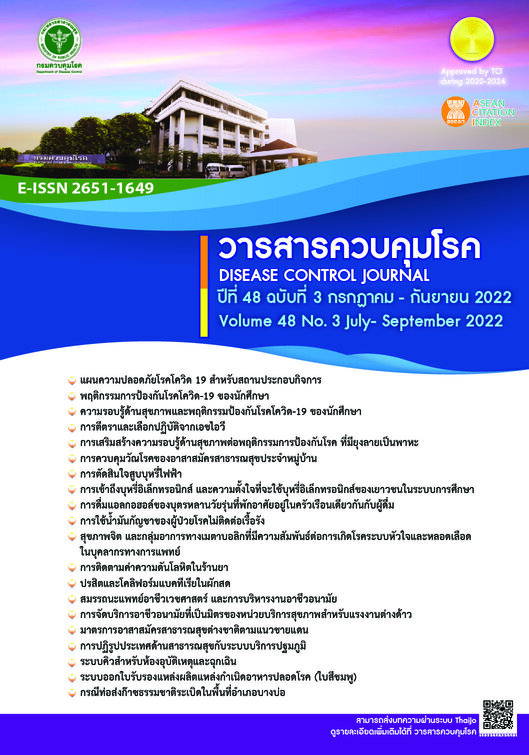Detection of Parasitic Contamination and Coliform Bacteria in vegetables from Ongkharak market in Nakhon Nayok province
DOI:
https://doi.org/10.14456/dcj.2022.52Keywords:
Parasite, Coliform Bacteria, Vegetables, SedimentationAbstract
Parasitic infectious diseases are still a public health problem in Thailand. In addition to being infected with parasites due to consumption of fresh vegetables, consumers were also at risk of getting coliform bacteria. Therefore, this research aimed to determine parasitic contamination and contamination of coliform bacteria in fresh vegetables by using a sedimentation technique and the SI-2 coliform bacteria test kit. The selection of vegetable samples in the research focused primarily on popular vegetables to be eaten fresh and readily available in the local wet markets. Five varieties of fresh vegetables, 9 samples each, including coriander, spring onion, lettuce, peppermint, and celery were obtained from Ongkharak Market, Nakhon Nayok province. Laboratory results found 79.8% and 46.6% of intestinal protozoa and helminths, respectively. The most parasitic contamination was found in 100% of mint, followed by 88.8% and 55.5% of spring onion and coriander, respectively. The most common parasites were Cyclospora cayetanensis (37.7%), followed by Ascaris lumbricoides, Giardia lamblia and Blastocystis hominis, which were found as the same proportion of 17.7%. Contamination of coliform bacteria was found in 64.4% of sample vegetables. The highest contamination was found in coriander, lettuce and celery at 77.7%, followed by spring onion at 66.6%. The detection of parasites and coliform bacteria contamination in each type of fresh vegetables had no statistically significant difference (p=0.237, p=0.085). The results of the study demonstrated that the contamination of parasites and coliform bacteria in fresh vegetables has affected the health of consumers. Therefore, relevant health authorities should educate people on proper washing of vegetables before consumption.
Downloads
References
Sajjapala T, Tansakul K, Phetnok K. Contamination of parasites and parasitic reduction in fresh vegetables by washing. Bull Dept Med Sci. 2014;56(4):205-12. (in Thai)
World Health Organization. Prevention and control of intestinal parasitic infections. Report of a WHO Expert Committee. World Health Organ Tech Rep Ser. 1987;749:1-86.
Boonjaraspinyo S, Boonmars T, Kaewsamut B, Ekobol N, Laummaunwai P, Aukkanimart R, et al. A cross-sectional study on intestinal parasitic infections in rural communities, northeast Thailand. Korean J Parasitol. 2013;51:727-34.
Chongkonnee N, Songthamwat D. Detection of parasite contamination in fresh vegetables From Phra Nakhon Si Ayutthaya District Phra Nakhon Si Ayutthaya Province. J Med Technol. 2015;43(1):5142-50. (in Thai)
Katasrila P, Laochan S Contamination of Ascaris eggs in 9 fresh vegetables at Rom Hup Market, Samut Songkhram province, Thailand. JAHS SSRU. 2014;3(1):45-2. (in Thai)
Punsawad C, Phasuk N, Thongtup K, Nagavirochana S, Viriyavejakul P. Prevalence of parasitic contamination of raw vegetables in Nakhon Si Thammarat province, southern Thailand. BMC Public Health. 2019;19:34.
Phoomphak N, Paworn L, Sansomchai P, Tangpoonlert N, Chansathien O. Detection of Escherichia coli in Fresh Vegetables from Makham Tao Market. In: Boonchareon S, editors. Proceeding of the 6th National academic conference Nakhon Ratchasima College; 2019 Mar 30; Nakhon Ratchasima College, Nakhon Ratchasima Province, Thailand. Nakhon Ratchasima Province; 2019. p. 1047-2. (in Thai)
Division of Innovation and Research, Department of Disease Control (TH). Research plan on disease prevention, control and health hazards. 2019-2021. (in Thai)
Health Data Center. Information and Communication Technology Center: Office of the Permanent Secretary Ministry of Public Health. Illness with important communicable diseases [Internet]. 2020 [cited 2021 Sep 12]. Available from: https://hdcservice.moph.go.th/hdc/reports/report.php?source=formated/format_2.php&cat_id=7f9ab56b0f39fd053143ecc4f05354fc&id=309e77ea6f4c09faa9bcf75a8c9aee13
Krejcie RV, Morgan DW. Determining sample sizes for research activities. Educational and Psychological Measurement. 1970;30:607-10.
Somnuek C, Charoenwised L. Coliform Bacteria Examination in Ready to Eat Food at Rambhai Barni Rajabhat University. RRBR. 2016;10(2):89-4. (in Thai)
International Commission on Microbiological Specification for Food (ICMSF). Microbial ecology of food: Food commodities. Academic Press Inc. 1980;2:606-12.
Anamnart W. Survey of Infection Stage of Strongyloides stercoralis in fresh vegetables at Thasala Food Market, Nakhon Si Thammarat. Vajira Med J. 2007;51:129-33. (in Thai)
Kaewpitoon S. Opportunistic intestinal parasitic infections in AIDS patients [Internet]. 2007 [cited 2020 Dec 26]. Available from: http://www.cmp.ubu.ac.th/th/detail_article.php?article=00084&=53e 9abafa1e152940c0e9abd7e318ee5 (in Thai)
Thathaisong U. Important Food-Borne and Water-Borne Pathogenic Parasites in Thailand. BUSCIJ. 2012;17:212-20. (in Thai)
Chengmak KB. Hominis [Internet]. 2007 [cited 2020 Dec 26]. Available from: https://kb.psu.ac.th/psukb/bitstream/2553/3076/9/237096_ch1.pdf (in Thai)
Chungsamanukool P, Rattanadilok Na Phuket N, Kantaeng K. Microbial Contamination in Raw Vegetables. Bull Dept Med Sci. 2010;52:30-9. (in Thai)
Downloads
Published
How to Cite
Issue
Section
License
Copyright (c) 2022 Disease Control Journal

This work is licensed under a Creative Commons Attribution-NonCommercial-NoDerivatives 4.0 International License.
Articles published in the Disease Control Journal are considered as academic work, research or analysis of the personal opinion of the authors, not the opinion of the Thailand Department of Disease Control or editorial team. The authors must be responsible for their articles.






